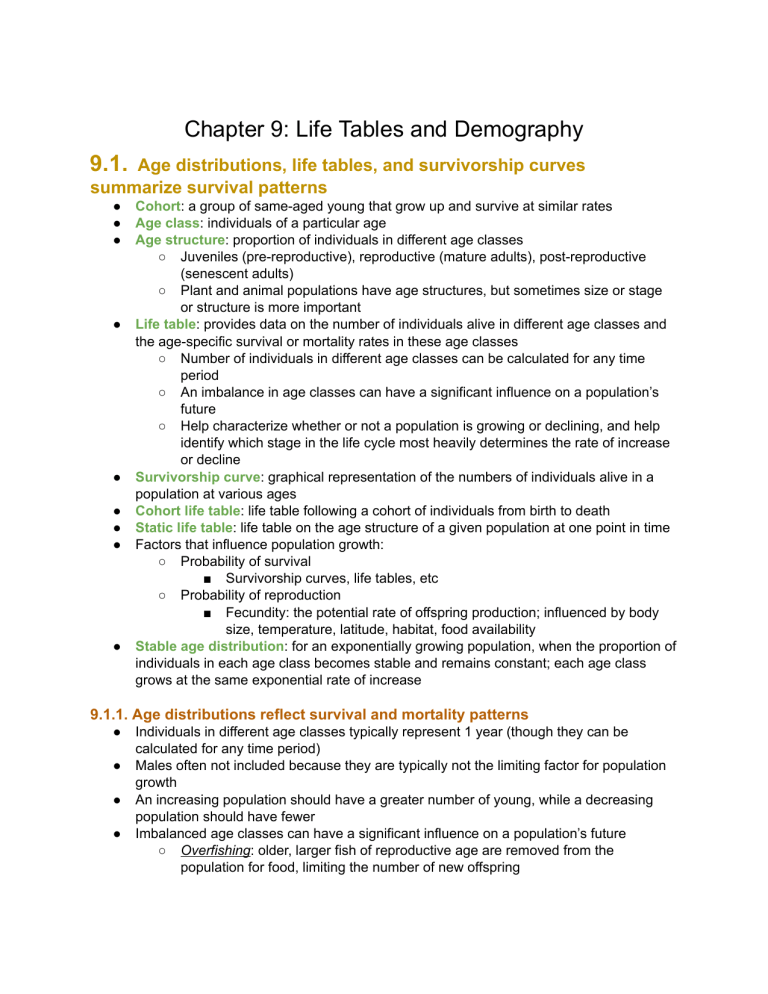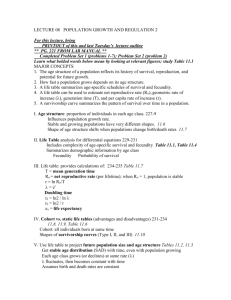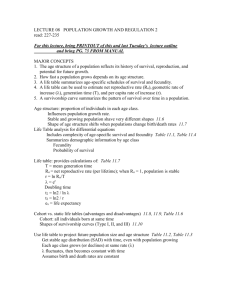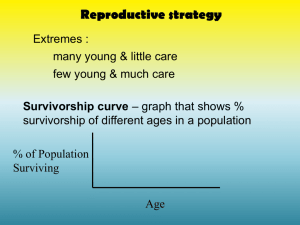
Chapter 9: Life Tables and Demography 9.1. Age distributions, life tables, and survivorship curves summarize survival patterns ● ● ● ● ● ● ● ● ● Cohort: a group of same-aged young that grow up and survive at similar rates Age class: individuals of a particular age Age structure: proportion of individuals in different age classes ○ Juveniles (pre-reproductive), reproductive (mature adults), post-reproductive (senescent adults) ○ Plant and animal populations have age structures, but sometimes size or stage or structure is more important Life table: provides data on the number of individuals alive in different age classes and the age-specific survival or mortality rates in these age classes ○ Number of individuals in different age classes can be calculated for any time period ○ An imbalance in age classes can have a significant influence on a population’s future ○ Help characterize whether or not a population is growing or declining, and help identify which stage in the life cycle most heavily determines the rate of increase or decline Survivorship curve: graphical representation of the numbers of individuals alive in a population at various ages Cohort life table: life table following a cohort of individuals from birth to death Static life table: life table on the age structure of a given population at one point in time Factors that influence population growth: ○ Probability of survival ■ Survivorship curves, life tables, etc ○ Probability of reproduction ■ Fecundity: the potential rate of offspring production; influenced by body size, temperature, latitude, habitat, food availability Stable age distribution: for an exponentially growing population, when the proportion of individuals in each age class becomes stable and remains constant; each age class grows at the same exponential rate of increase 9.1.1. Age distributions reflect survival and mortality patterns ● ● ● ● Individuals in different age classes typically represent 1 year (though they can be calculated for any time period) Males often not included because they are typically not the limiting factor for population growth An increasing population should have a greater number of young, while a decreasing population should have fewer Imbalanced age classes can have a significant influence on a population’s future ○ Overfishing: older, larger fish of reproductive age are removed from the population for food, limiting the number of new offspring ○ Overgrazing: white-tailed deer overgraze vegetation and young trees, leaving only older trees with foliage too far from the ground for them to reach; when the older trees die, there are no young trees to replace them. 9.1.2. Static life tables provide a snapshot of a population’s age structure from a sample at a given time ● ● ● Static life table: life table on the age structure of a given population at one point in time Life table variables, symbols, and equations: VARIABLE SYMBOL EQUATION Age class x Interval at which age classes occur Number alive at a specified age nx Number of individuals alive at the start of each age class interval Age-specific mortality dx dx = nx - nx + 1 Probability at birth of surviving to a given age lx lx = nx / n0 Age-specific mortality rate qx qx = dx / nx Average number alive in age class Lx Lx = (nx + nx + 1) / 2 Total years lived Tx Tx = ∑ Lx Life expectancy ex ex = (Tx / nx) Age-specific fertility mx Average number of female offspring born to a female parent of age x Net reproductive rate R0 R0 = ∑ lx mx Static life table limitations: ○ Assumes birth and death are constant through time ■ Example: If the rate of mortality is equal for 2-year-old sheep and 4-year-old sheep, but there are more 2-year-old sheep born in a particular year due to favorable conditions, a greater number of 2-year-old sheep would die of that age class leading to the assumption of a higher rate of mortality in 2-year-olds ○ Assumes you sampled each age class in proportion to its numbers in the population ■ ○ No independent method for estimating the birth rates of each age class yet exists Methodologically difficult to assess the age structure of a population; can be done for species with growth rings, such as trees, fish scales, horns, sea urchins, and some mollusks 9.1.3. Cohort life tables follow an entire cohort of individuals from birth to death ● ● ● Cohort life table: start with a group of individuals born in the same time frame/age class, record their deaths until the cohort is all dea; can be age or stage based Population censuses must be conducted frequently, but for a limited amount of time (generally less than a year for insects or annual plants) ○ Age classes typically measured in weeks or months instead of years More accurate than static life tables 9.1.4. Survivorship curves present survival data graphically ● ● ● Survivorship curves: graphically represent organismal survival at each age from static or cohort life tables Typically represented with age on the x-axis, and the logarithmic value of nx on the y-axis ○ Logarithmic scale allows the study of rates of change with time as opposed to change in absolute numbers; also makes it easier to examine a wide range of population sizes Survivorship curves graphically represent organismal survival from both static or cohort life tables ○ Type 1: most individuals die late in life (ex: humans) ○ Type 2: individuals die at a uniform rate (ex: squirrels) ○ Type 3: most individuals die at a young age (ex: octopuses) Feature Investigation: Frederick Barkalow Jr. and colleagues constructed a cohort life table for the Eastern Gray Squirrel ● Eastern gray squirrel is an important game animal in North America; Barkalow and colleagues wanted to evaluate the effects of artificial nest boxes on populations ○ Team constructed a cohort life table for an area without nest boxes and another for an area with nest boxes ○ Study found that nest boxes increased squirrel survival by reducing the mortality associated with predation and bad weather for both young and adult squirrels Global Insight: Hunting, over-collecting, and grazing can greatly affect survivorship curves ● 9.2. Age-specific fertility data can tell us when to expect population growth to occur ● Age-specific fertility and survivorship data help determine the overall growth rate per generation called the net reproductive rate (R0) ○ Age-specific fertility (mx): the proportion of female offspring that are born to females of reproductive age ○ ○ Net reproductive rate (R0): the average number of female offspring produced by all the females in a population over the course of a generation, where a generation constitutes the reproductive life of a female Generally, generation time increases as organismal size increases



